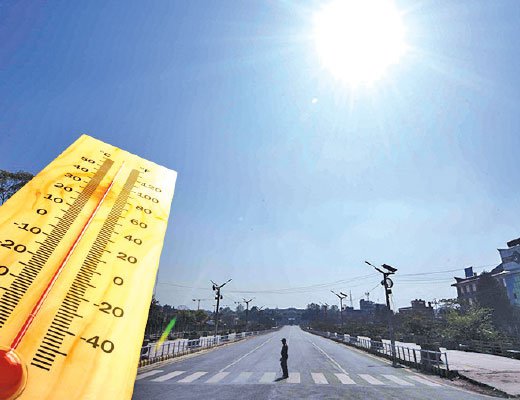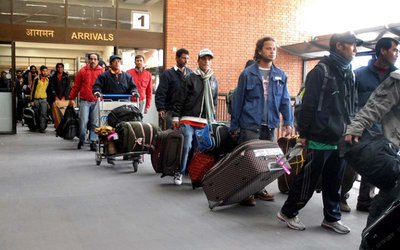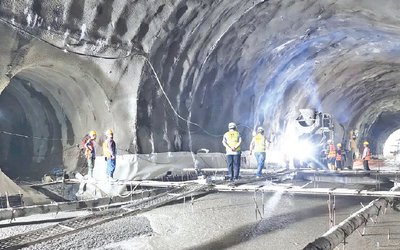
If the temperature in the bay is more than 50 degrees, there is no city worth living in, even if it is more than 50 degrees, one of my friends, who is a resident of that place, came to Nepal, he said.
Guterres is a former Prime Minister of Portugal and is in his second term as Secretary General of the United Nations. Visiting Nepal UN Secretary General Antonio Guterres has said that climate change has badly affected the Himalayan region of Nepal.
It is remembered that he said that he saw the terrible effects of the climate crisis from the base of the world's highest peak, Mount Everest. "Today, from the base camp of Mount Everest, I have seen the terrible effects of the climate crisis in the Himalayas," he wrote on the social network X. "As temperatures rise, glaciers melt faster, threatening the lives and livelihoods of entire communities." He said that the glaciers of the Himalayas started to melt while setting records. He said that the sea level is rising in the Arctic as well as in Greenland. "Here we see landslides.
We see communities dramatically affected. We have to stop this. We have to make sure we limit temperature rise to 1.5 degrees," said Secretary-General Guterres. Secretary-General Guterres expressed his commitment to do what can be done to reduce the problems caused by climate change and take the message to the world.
The local residents of Nepal informed the Secretary General Guterres about the increasing melting of glaciers, increased damage caused by climate, drying up of water sources, the impact of climate on local crops, and the problem of landslides in the Himal without any plntations when it rains.
In Nepal, it has been observed that the temperature has been increasing significantly in various places of the country for the past few days. According to the Department of Water and Meteorology, the temperature has increased significantly in most places of the country due to less active weather activity that causes rain.
It is said that there is a partial effect of the low pressure system around Bihar in India along with the partial effect of local air and western air in Nepal.
At present, it is partly to mostly cloudy in the hilly areas including Koshi and Sudurpaschim Province, but the weather is mainly clear in the rest of the area. Recently, the maximum temperature in Nepalgunj was measured at 44.2 degrees, according to the Department of Hydrology and Meteorology, Weather Forecasting Division.
Similarly, the temperature is increasing in Kathmandu and Pokhara as well. The temperature has been measured at 34 degrees in Pokhara and 34.4 degrees in Kathmandu.
We see, for thousands of years we have had a fairly stable climate. And we have settled in areas with favorable climates and ignored areas that are not. All that is changing.
Eventually new stable climate patterns will emerge. How long it takes and how much it changes depends on what we all do over the next decade. But when a new climate pattern emerges, we will have to abandon areas that are no longer easily habitable and rebuild in areas that now have a more favorable climate.
As the temperature increases, there may be health problems, the relevant Department in Nepal has asked to be cautious. According to the World Health Organization, health problems such as fatigue, weakness, excessive thirst, headache, leg cramps, and fainting occur due to high temperature.
Similarly, the department has requested that people stay indoors in a cool place, drink water and soft drinks, bathe with cold water and take the advice of health workers during the hot season.
Causes and consequences of climate change Climate change could push 40 million people into poverty in South Asia alone. Our challenge cannot be met by the government alone.
There is hardly anyone who does not wonder about our planet Earth and the relationship of humans with it when they see the high mountains while landing in Kathmandu. These mountain ranges are an invaluable source of water for the 250 million people in the Hindu Kush Himalayan region and an additional 1.65 billion people in the lower coastal regions. Therefore, Nepal is the fourth most vulnerable country in terms of climate change. Snow Lake and Snow River According to the experts concerned, the glaciers are shrinking at a rate of 60 meters per year, which is why glaciers are forming and the possibility of floods due to the bursting of glaciers has increased.
It is to be remembered, this matter has not been given the expected importance. It doesn't need to change, but carbon emissions will halve every decade from 2050.
Getting there will require a rapid shift to renewable energy, building new electricity networks, increasing energy efficiency and adopting low-carbon transport.
COP- 28 and Nepal
This Special Issue on Climate, in partnership with the United Nations Climate Change Conference (COP 28), Nepal seized the unique opportunity to bring together a diverse range of voices from academics, policy makers, the private sector and youth activists.
Recommends involve: credible carbon pricing policies to encourage the use of green energy, Advocates for changes in sector-specific policies such as low-carbon aviation fuels.
For the UN Special Envoy for Climate Action and Finance, private finance can help turn billions of public money into billions of total climate investments. It is remembered for proposing ways to measure clean and green financial flows to emerging and developing countries.
Nepal has prioritized and will prioritize the impact of climate change in mountainous regions at COP 28. 2024 looks likely to break 2023's record due to hotter days or an increase in temperature. Oceans are "sinks" of heat, as the ice phase changes.
The thawing permafrost/tundra in Siberia and Alaska and northern Canada is filled with previously frozen dead stuff, which will now decay. That decomposition will produce methane and carbon dioxide, adding to the atmospheric carbon we see directly in the atmosphere.
Areas of Earth that were once covered by ice and are now not are reducing the planet's albedo, thereby increasing Earth's ability to shield heat from sunlight. Average temperatures or precipitation may have changed little, but those figures hide high and low extremes.
And it's those extremes that are imposing the costs. The first and most obvious damage is caused by changing weather patterns. Unusual rainfall, droughts and more intense storms are causing damage to people and property that would not happen if we as a nation listened to science and acted accordingly.
And to deal with this more extreme weather we need to invest more money to manage the consequences. For example, buy more snow plows, spend more on levees and drainage, invest more in disaster relief agencies.
It has caused damage to agriculture. Farmers rely on predictable weather patterns to plan when sowing and harvesting their crops. Traditionally they knew that spring is usually wet and summer is hot and dry. Weather patterns are becoming more erratic and unpredictable, resulting in lower production and increased costs. Another area is the availability of drinking water. Changing rainfall patterns are beginning to affect water supplies in many parts of the world. When it rains it rains a lot, in some cases with a month's worth of rain in one day. Conventional water management schemes are unable to store all that rainfall and the priority is to drain it as efficiently as possible and therefore it is wasted.
This is followed by days without rain, which immediately leads to concerns about reservoir levels falling. To deal with this we will have to spend money on more and bigger reservoirs and other water management projects.
Areas that rely on glaciers for their fresh water supply are also a concern. Many of these are declining rapidly. Once they disappear, the fresh water supply for the entire community will dry up.
Either that supply would have to be expensively replaced or communities would have to be expensively relocated. Coastal communities will also have to invest more in marine security and accept that some assets will have to be sacrificed.
There are many other impacts of climate change that we will be able to deal with, but at a price. However there is one issue that is now starting to get some attention. And this is one area that could have the most serious consequences for us. This is because it appears that animal species in general and insects in particular are not as resilient as humans when it comes to more extreme climates. Research in this regard is still at an early stage but if it is discovered that, for example, bee hives cannot withstand very unusually hot summer days, the consequences for crops that need pollination could be disastrous. Reducing average emissions per person per year is essential to combat climate change. From the way we travel to the electricity we use, the food we eat and the things we buy, we can make a difference. Actions required will include: saving energy at home, reducing carbon footprint when traveling, adopting a maintenance policy, recycling and reducing: reducing consumption of materials, eating more vegetables to reduce greenhouse gas emissions, switching to renewable sources such as wind or solar, Switch from a petrol or diesel-powered car to an electric vehicle to reduce your carbon footprint, reduce environmental impact by choosing products from companies that use resources responsibly and are committed to cutting back.
Actions required will include: saving energy at home, reducing carbon footprint when traveling, adopting a maintenance policy, recycling and reducing: reducing consumption of materials, eating more vegetables to reduce greenhouse gas emissions, switching to renewable sources such as wind or solar, Switch from a petrol or diesel-powered car to an electric vehicle to reduce your carbon footprint, reduce environmental impact by choosing products from companies that use resources responsibly and are committed to cutting back.
Spread awareness by talking to your neighbors, colleagues, friends and family about their gas emissions and the need to avoid waste, energy, water and waste for collective action, practice planting trees in the right places, and avoid completely unplanned constructions, reduce the use of plastic, because It's made from oil, and the process of refining and turning oil into plastic (or polyester, even for clothing) is carbon-intensive, supporting more local businesses that use it. and promote sustainable, climate-smart practices.
The energy in our weather system can push cold air from the northern polar regions further south than normal – causing temporary cold weather in southern climates. Meanwhile, the weather on the west coast is warmer than normal. According to the opinion of some experts in Nepal, it is not the highest temperature ever recorded in Nepal, but it is interpreted as "too many hot days".
The highest temperature in Nepal so far is 46.4 degrees Celsius, which was recorded on June 16, 1995 at the measuring station in Dhangadhi.
The highest rainfall in Nepal is about 80% in monsoon and 5% in post-monsoon. The share of rainfall in winter is considered to be around 4 percent. But since the previous winter, such a cycle has been broken.
The annual contribution of last winter rainfall is very less i.e. only 0.3 percent. Monsoon is a zonal system, whereas the pre-monsoon has the same source of moisture but receives rainfall from local sources. But sometimes during the cyclone the influence of the surrounding system is seen in the pre-monsoon through the westerly winds.
The goal should be to recognize the critical role of nature-based solutions in both mitigation and adaptation to climate change. Nature-based solutions such as forest restoration, water resource management, wetland restoration and riverside planting have proven effective in Nepal, providing benefits beyond disaster risk reduction.
The Meteorological Department currently lacks the technology and resources to predict when heat wave conditions may occur. The water and weather forecasting division under the department has been giving three-day weather forecast and estimated weather information for up to one week.
How to avoid?
Heat waves can be fatal. The latest example of this can be taken in Maharashtra, India, where 13 people died due to heatstroke during a program held in Mumbai in the midst of extreme heat. Due to the heat wave, heatstroke, ringing, and excessive fatigue are seen.
Drinking plenty of soft drinks including water, staying indoors or under the roof, and going to a health facility in case of any difficulty are the solutions to the current problem.
- Susan's “U-Turn” From Atheism To Spirituality And Superstition: Some Considerations
- Jun 29, 2025
- Former Ambassador To People’s Republic Of China Acharya's 'Diplomatic Diary': A Collection Of "Autobiography " Including Diplomacy
- Jun 17, 2025
- Banker And Businessman Being The Same Person: How Practical, How Impractical
- Jun 01, 2025
- 2082/83 Policy And Program: Presentation New, Short But Not Exciting
- May 07, 2025
- Nepal's Capital Market: Some Analysis
- May 02, 2025













